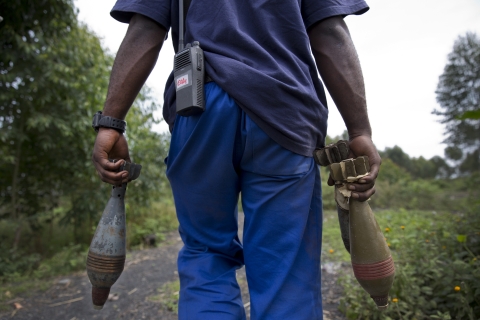
Violence in the eastern DRC provinces of North Kivu and Ituri highlight the precarity of the country’s security due heavily armed rebel groups, foreign intervention, and battle over access to the DRC’s mineral reserves.
The following article was published in the May-June 2024 issue of NewsNotes.
Serious fighting in February between the Congolese Army and rebel group, M23, resulted in over 150 civilians killed since hostilities resumed in November, 738,000 displaced people in the first three months of this year, and some 400,000 people descended on the city of Goma, causing a major cholera outbreak.
The Catholic bishops of Bukavu Province have decried: “Insecurity has become endemic, with its trail of killings even in the middle of the day, massacres and kidnappings of peaceful citizens in our towns and villages.” International aid agencies state that they will need $2.6 billion this year alone, to help some 8.7 million vulnerable people in the country. The conflict in eastern DRC has in fact been going on for thirty years, with at least ten million killed in that time.
The M23 rebel group is made up of Congolese Tutsi, most of whom left Rwanda after the 1994 genocide, and it is funded and armed by Rwanda, as it is fighting another rebel group in that area, the Forces for the Liberation of Rwanda (FDLR), made up of Hutus, who were the perpetrators of the genocide.
Although Rwanda denies it is aiding M23, the United Nations has stated that it has evidence that Rwandan troops have fought alongside the M23 in eastern Congo and supplied the rebels with weapons, and that members of the Congolese Army have fought with the FDLR. The United States has stated: “Rwandan forces must withdraw from Congolese territory.”
The government army is also assisted by some local militia and by troops from Burundi and the Southern African Development Community (SADC), from Tanzania and South Africa. However, M23 has been supplied with extremely lethal weapons by Rwanda. UN Secretary General Antonio Guterres has stated, “The truth is that M23 is now a modern army, with heavy equipment that is more sophisticated than Monusco’s equipment. These weapons have come from somewhere.” Monusco is the UN force assigned to try to bring security to eastern Congo, although the conflict has been getting worse.
So effective militarily is M23 that it was able to bomb Goma’s airport with army attack drones, destroying a number of Congolese military aircraft. Compounding the fight between Congolese and Rwandan forces are the presence of over 100 smaller armed groups, some of them vicious. Many are more like ghost gangs that meld into the civilian population when not fighting, making them difficult to track down.
Another factor fueling the conflict is the abundance of highly valuable minerals in the DRC, especially of the minerals essential for modern technology—coltan and cobalt. The DRC contains 70 percent of the world’s coltan and over 60 percent of the world’s cobalt. It also has large copper deposits and is set to be the world’s second largest producer of copper by 2027, right behind Chile. Other minerals in the DRC include lithium, germanium, cassiterite, tungsten, zinc, rare earths, silver, gold, and diamonds. In all, it is estimated that its reserves in the ground are worth $24 trillion, many of which are illegally mined and traded internationally. It was the mineral wealth that drew in many countries to the civil war in the 1990s after the death of long-time dictator Mobutu Sese Seko.
In February 2013, after the newly formed M23 group had been driven out of Goma by a combination of Congolese and international forces, eleven countries signed the Framework Agreement on Peace, Security and Cooperation in the DRC, which included specific commitments to promote peace. Despite this, insecurity and conflict have persisted.
In February of this year a peace initiative was begun in Nairobi. Unfortunately, it coincided with the resumption of fighting by M23, dashing hopes for peace talks. DRC President Felix Tshisekedi has stated that “he will never hold talks with the M23.” His spokeswoman, Tina Salama, says: “President Tshisekedi wants dialogue only with Rwanda, but not at any price. Talks with Rwanda are possible only if Kigali withdraws its troops from Congolese soil.”
Fighting has not intensified beyond the levels seen in February 2024, but observers say it seems that all sides are preparing for a deadly escalation. This could lead to the whole region being destabilized.
Bintou Keita, the UN representative to the DRC, states bluntly: “It is crucial to stress the risk of the conflict spreading to the whole region if the ongoing diplomatic efforts to reduce tensions and find lasting political solutions to the current conflict fail.”
Photo of the United Nations Mine Action Coordination Centre (UNMACC), MONUSCO's Mine Action section, clearing Unexploded Ordnance (UXO) in and around the Goma-Kibati area following the recent conflict between FARDC and M23 rebels. A member of the demining team recovers abandoned ammunition from the battlefield. Goma, Democratic Republic of the Congo. Photo/Sylvain Liechti via Flickr.
